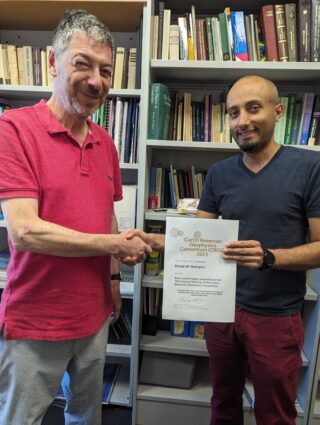2023 CRGC Annual Meeting
The 2023 Curtin Reservoir Geophysics Consortium Annual Meeting was held in hybrid mode (in-person and online) from the 5th to 7th of December 2023 over three afternoons from 1:00pm to 5:00pm.
For further information please visit the CRGC webpage.
Presentations
Day 1 – 5th 2023
- Welcome and Housekeeping Boris Gurevich
- Effect of changes of elastic properties of thin layers on downhole DAS amplitudes of Rayleigh waves – field data analysis – Roman Pevzner
- Effect of changes of elastic properties of thin layers on downhole DAS amplitudes of Rayleigh waves – theory and modelling – Boris Gurevich
- What formation properties control amplitudes of direct P waves from active and passive seismic sources? – Boris Gurevich
- Numerical simulation of the effect of CO2 on direct-wave DAS amplitudes from permanent sources – Wanting Hou
- Reliability of downhole elastic property estimates from regional earthquakes – Pavel Shashkin
- Detection of a CO2 plume with P waves from surf breaks recorded on borehole DAS – Roman Isaenkov
- Long-term repeatability analysis of time-lapse DAS VSP data acquired with permanent sources: CO2CRC Otway case study – Roman Isaenkov
Day 2 – 6th 2023
- Monitoring microseismicity induced by CO2 injection – Stanislav Glubokovskikh
- A Supervised Deep Learning Approach for Source Location and Subsurface Characterisation Using Passive DAS Data – Emad Al-Hemyari
- Denoising DAS data using deep learning. Supervised training using synthetic signals and recorded hardware noise – Xihao Gu
- Denoising DAS data using deep learning. Using the Noise2Noise Approach to Remove Hardware Noise – Olivia Collet
- Full waveform inversion of Otway offset VSP data – Hyunwook Jo
- Monitoring injected CO2 using refracted waves: Gippsland and Otway feasibility studies – Roman Pevzner
- Detecting sound produced by whales in DAS data – Leander Erbe King
- Multichannel analysis of surface waves recorded by geophones and DAS – Konstantin Tertyshnikov
Day 3 – 7th 2023
- 3C seismic with DAS and electromagnetic vibroseis source – Konstantin Tertyshnikov
- Nonlinear Effects on Vibroseis Signals Recorded by Downhole DAS – Valeria Shulakova
- Laboratory measurments of elastic properties using DAS: insights from noise recordings in the laboratory environment – Olivia Collet
- Seismic imaging and monitoring using low-power and ambient sources – Nikita Beloborodov
- Using rigorous bounds to estimate porosity Graeme Milton
- Rigorous Bounds for Attenuation in Fluid-Saturated Rocks – Boris Gurevich
- Estimating mechanical properties of rocks from cuttings – Maxim Lebedev

Centre for Exploration Geophysics Director, Professor Boris Gurevich (left) handing the award certificate to Emad Al-Hemyari (right).
Best Student Presentation Award
By sponsors’ nominations, Emad Al-Hemyari was selected as the awardee of the Best CRGC annual meeting student presentation. His talk was titled “A Supervised Deep Learning Approach for Source Location and Subsurface Characterisation Using Passive DAS Data”.
